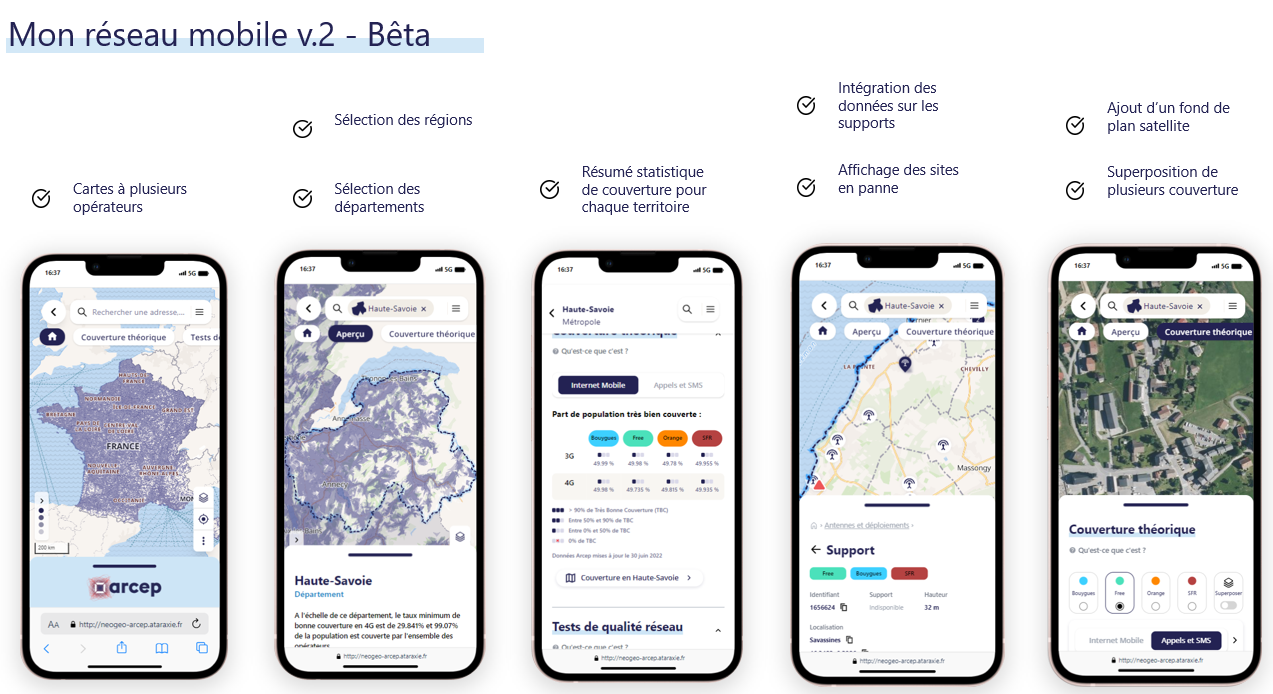Launched by Arcep in 2018, the map-based “Mon réseau mobile” (My mobile network) website gives users the ability to obtain coverage and quality of service information for each of the country’s mobile operators. In a bid to improve the site’s user-friendliness, and provide a more fluid, streamlined and informative experience, today Arcep is launching the beta version of the redesigned “Mon réseau mobile” site. A call for contributions is being issued to all those who would like to become beta testers for the site’s new features, and to provide feedback on their user experience. The definitive version of the site is due to be online by the first half of 2025. It will also be enhanced with information on coverage levels for mobile data services, as it already provides for voice and texting/SMS services.
The new “Mon réseau mobile” site: a redesigned user interface and new features
Drawing on best practices in online mapping, Arcep assembled a dedicated team of designers, UX/UI designers, geographers and developers. Several workshops were held with consumers and local authority representatives to help redesign the interface. The beta version being released today gives every user the ability to test the application’s first features and provide Arcep with feedback on their experience.
This beta version of the redesigned “Mon réseau mobile” is available at the following URL: https://monreseaumobile.arcep.fr/beta-access/
The beta version has an entirely revamped interface. Special attention has been given the clarity of the coverage maps, which adapt dynamically to the zoom level, guaranteeing a fluid and intuitive user experience, regardless of the browsing context. It also allows users to obtain detailed technical information on radio masts and towers, such as height, orientation and the technologies they use.
To complete this arsenal of mobile coverage diagnostic tools made available to consumers and local authorities, this new version includes territorial statistics that are tailored to the area selected. A satellite background map has also been introduced, to make it easier to find one’s bearings on the maps.
All of these developments were achieved with stringent requirements in terms of openness, interoperability and transparency. The tool thus makes use of public data (such as the OpenStreetMap background map, Etalab mapping data, and IGN orthophotos) and was built using sovereign and open source technologies (such as MapLibre and Django)

N.B. This is a beta version: the data presented serve only to test the application’s future functions. For accurate and up to date information, Arcep invites users to visit the official site, here: https://monreseaumobile.arcep.fr/
Arcep is calling on users to test both the web and mobile versions of this new tool, and to share their suggestions for improvement
Beta testing in a crucial step in the new site’s development: it provides the opportunity to obtain comments and suggestions from users, and to assess the application’s performance. Every bit of feedback, every bug reported by beta testers will help improve the final version of the app.
Arcep has created a dedicated form for this beta testing process: https://framaforms.org/mon-reseau-mobile-beta-1716543411
Final version of “Mon réseau mobile” due to go live in the first half of 2025
In addition to the new features contained in the beta version, the definitive version will include quarterly updated data, and particularly the new multi-level 4G mobile internet maps, the ability to view aggregated QoS data, as well as tools for searching by address, distance and elevation measurements, and the ability to export maps as PNG files. Thanks to an optimised cache, the application will also deliver improved performance and even more seamless browsing.
“Mon réseau mobile” and data-driven regulation
Arcep began its data-driven approach to regulation in 2017 with the launch of the “Mon réseau mobile” (My mobile network) website. This form of action comes to complete the regulator’s traditional toolkit by providing users with personally useful information, such as the availability of services at a given address, the quality of the services on offer, mobile network coverage maps, etc. As an adjunct to regulatory prescriptions on regulated economic stakeholders, the Authority has hereby created the conditions for reducing information asymmetries, and empowering users to make informed choices. Data-driven regulation has two overarching goals:
• To give users the ability to make informed decisions to better steer the market;
• To amplify the regulator’s ability to take action, notably in a supervisory capacity.
This map-based site gives users the ability to view mobile operators’ theoretical coverage maps, as well as the results of Arcep’s annual QoS audits, which conducted under real life conditions and on a range of uses: call quality, web browsing, video streaming, etc.
Committed to continually improving its tools, to provide as faithful a reflection of the user experience as possible, Arcep has steadily enhanced the data made available to users: publication of local authorities’ field campaign findings and, more recently, opening the site up to crowdsourced data obtained by third-party testing apps that have declared themselves compliant with the Code of conduct.
Over time, users have expressed a desire to see further development of the application, to have access to more detailed and superimposable data and to enjoy a more user-friendly interface, designed for both computers and smartphones. These were Arcep’s starting points for the site’s complete redesign.
